SWOT Analysis of Business Environment and Its Impact
VerifiedAdded on 2020/10/23
|16
|4454
|490
AI Summary
The assignment delves into the importance of SWOT analysis in managing a business's internal and external environment. It highlights how this approach helps in identifying strengths, weaknesses, opportunities, and threats, which are then used to make informed decisions and strategies for the organization. A detailed study on McDonald's is provided as an example, showcasing how SWOT analysis can be applied to real-world businesses.
Contribute Materials
Your contribution can guide someone’s learning journey. Share your
documents today.
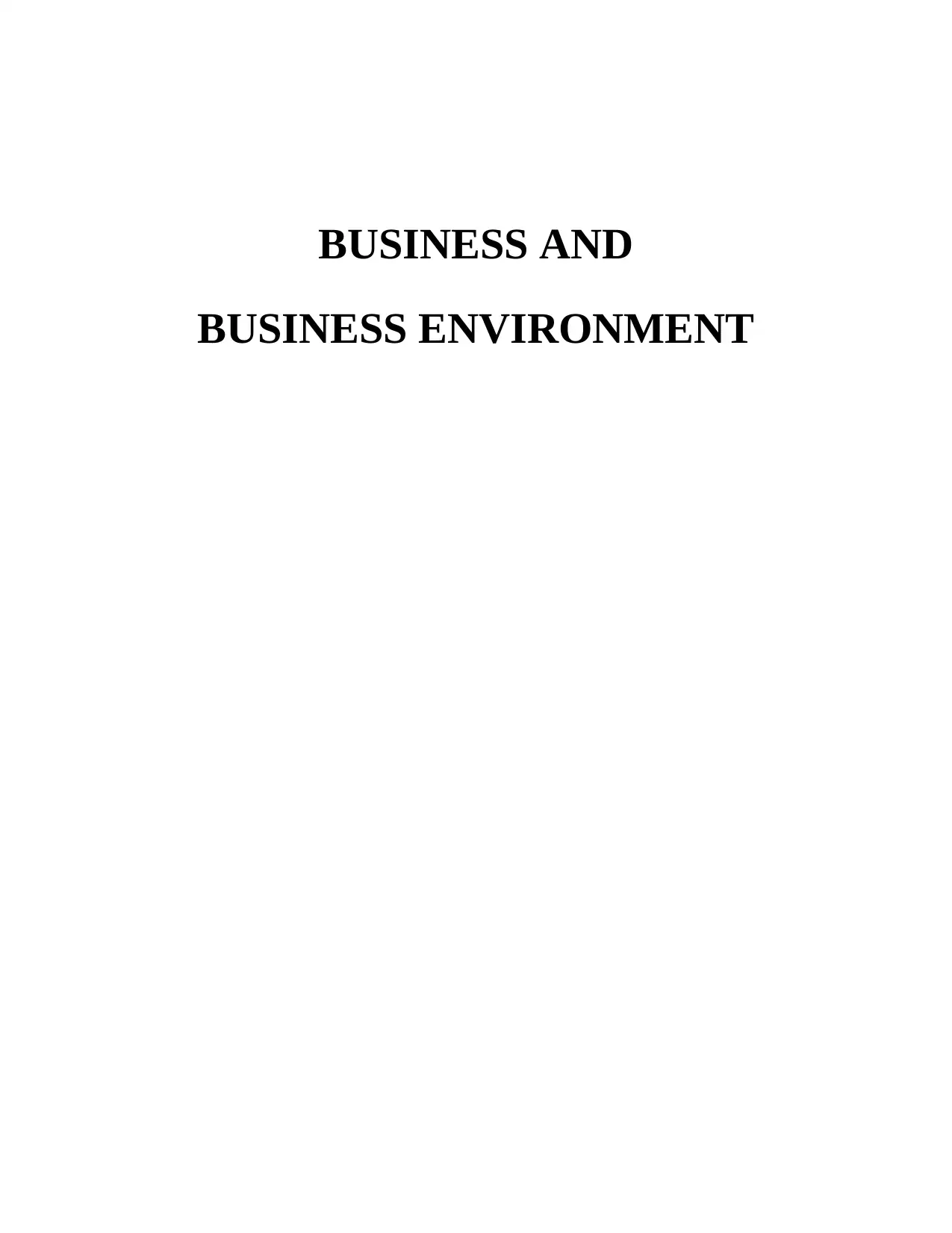
BUSINESS AND
BUSINESS ENVIRONMENT
BUSINESS ENVIRONMENT
Secure Best Marks with AI Grader
Need help grading? Try our AI Grader for instant feedback on your assignments.
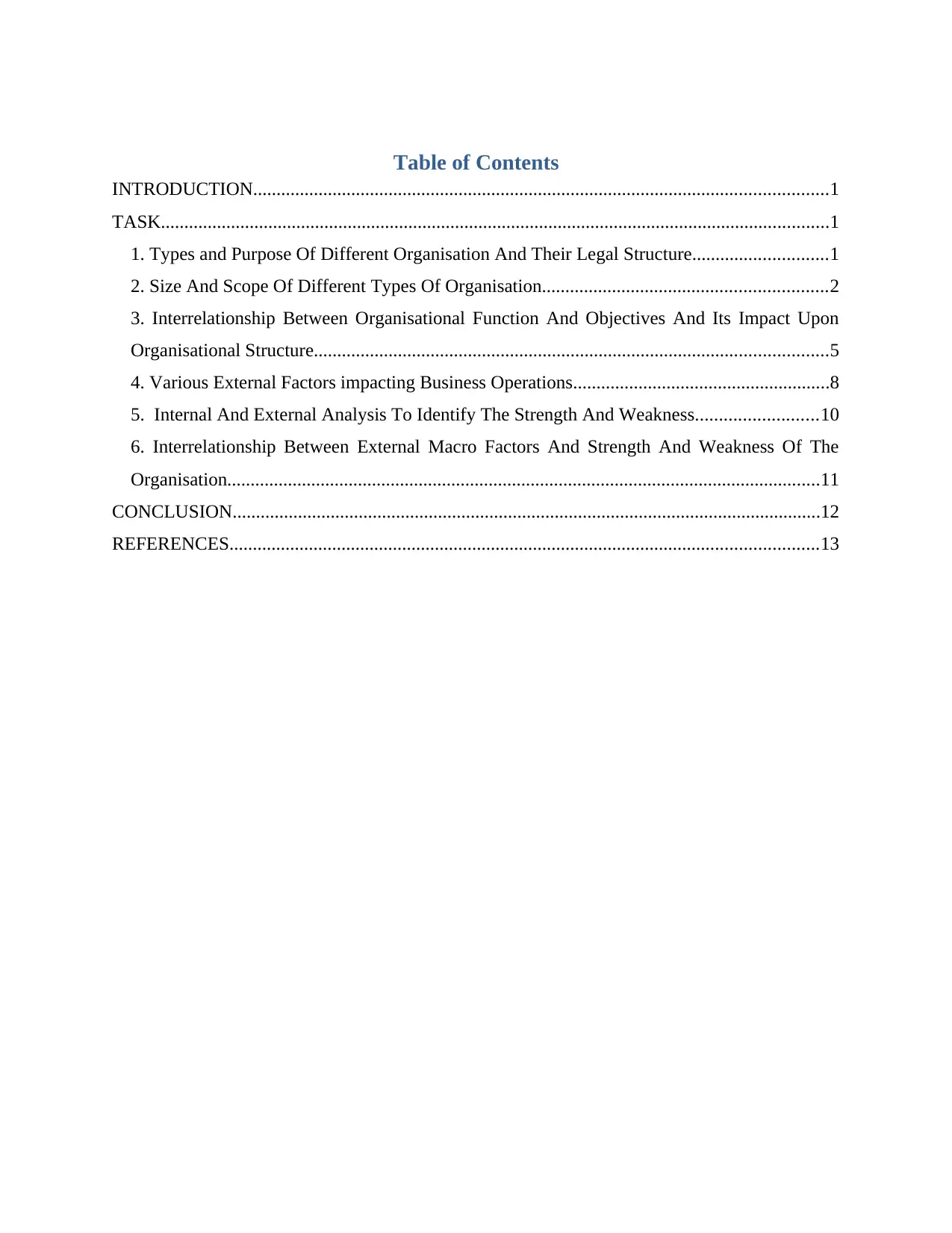
Table of Contents
INTRODUCTION...........................................................................................................................1
TASK...............................................................................................................................................1
1. Types and Purpose Of Different Organisation And Their Legal Structure.............................1
2. Size And Scope Of Different Types Of Organisation.............................................................2
3. Interrelationship Between Organisational Function And Objectives And Its Impact Upon
Organisational Structure..............................................................................................................5
4. Various External Factors impacting Business Operations.......................................................8
5. Internal And External Analysis To Identify The Strength And Weakness..........................10
6. Interrelationship Between External Macro Factors And Strength And Weakness Of The
Organisation...............................................................................................................................11
CONCLUSION..............................................................................................................................12
REFERENCES..............................................................................................................................13
INTRODUCTION...........................................................................................................................1
TASK...............................................................................................................................................1
1. Types and Purpose Of Different Organisation And Their Legal Structure.............................1
2. Size And Scope Of Different Types Of Organisation.............................................................2
3. Interrelationship Between Organisational Function And Objectives And Its Impact Upon
Organisational Structure..............................................................................................................5
4. Various External Factors impacting Business Operations.......................................................8
5. Internal And External Analysis To Identify The Strength And Weakness..........................10
6. Interrelationship Between External Macro Factors And Strength And Weakness Of The
Organisation...............................................................................................................................11
CONCLUSION..............................................................................................................................12
REFERENCES..............................................................................................................................13
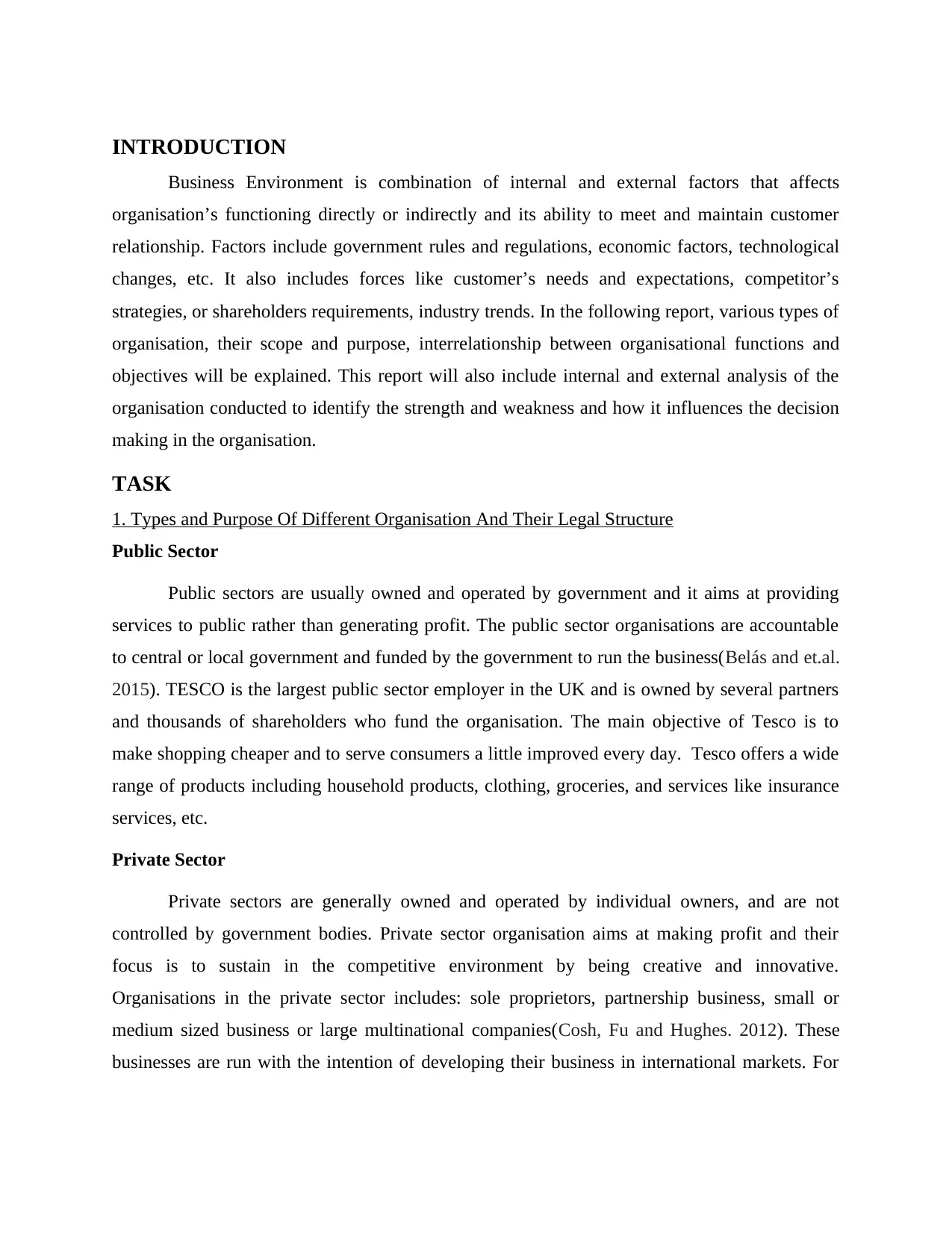
INTRODUCTION
Business Environment is combination of internal and external factors that affects
organisation’s functioning directly or indirectly and its ability to meet and maintain customer
relationship. Factors include government rules and regulations, economic factors, technological
changes, etc. It also includes forces like customer’s needs and expectations, competitor’s
strategies, or shareholders requirements, industry trends. In the following report, various types of
organisation, their scope and purpose, interrelationship between organisational functions and
objectives will be explained. This report will also include internal and external analysis of the
organisation conducted to identify the strength and weakness and how it influences the decision
making in the organisation.
TASK
1. Types and Purpose Of Different Organisation And Their Legal Structure
Public Sector
Public sectors are usually owned and operated by government and it aims at providing
services to public rather than generating profit. The public sector organisations are accountable
to central or local government and funded by the government to run the business(Belás and et.al.
2015). TESCO is the largest public sector employer in the UK and is owned by several partners
and thousands of shareholders who fund the organisation. The main objective of Tesco is to
make shopping cheaper and to serve consumers a little improved every day. Tesco offers a wide
range of products including household products, clothing, groceries, and services like insurance
services, etc.
Private Sector
Private sectors are generally owned and operated by individual owners, and are not
controlled by government bodies. Private sector organisation aims at making profit and their
focus is to sustain in the competitive environment by being creative and innovative.
Organisations in the private sector includes: sole proprietors, partnership business, small or
medium sized business or large multinational companies(Cosh, Fu and Hughes. 2012). These
businesses are run with the intention of developing their business in international markets. For
Business Environment is combination of internal and external factors that affects
organisation’s functioning directly or indirectly and its ability to meet and maintain customer
relationship. Factors include government rules and regulations, economic factors, technological
changes, etc. It also includes forces like customer’s needs and expectations, competitor’s
strategies, or shareholders requirements, industry trends. In the following report, various types of
organisation, their scope and purpose, interrelationship between organisational functions and
objectives will be explained. This report will also include internal and external analysis of the
organisation conducted to identify the strength and weakness and how it influences the decision
making in the organisation.
TASK
1. Types and Purpose Of Different Organisation And Their Legal Structure
Public Sector
Public sectors are usually owned and operated by government and it aims at providing
services to public rather than generating profit. The public sector organisations are accountable
to central or local government and funded by the government to run the business(Belás and et.al.
2015). TESCO is the largest public sector employer in the UK and is owned by several partners
and thousands of shareholders who fund the organisation. The main objective of Tesco is to
make shopping cheaper and to serve consumers a little improved every day. Tesco offers a wide
range of products including household products, clothing, groceries, and services like insurance
services, etc.
Private Sector
Private sectors are generally owned and operated by individual owners, and are not
controlled by government bodies. Private sector organisation aims at making profit and their
focus is to sustain in the competitive environment by being creative and innovative.
Organisations in the private sector includes: sole proprietors, partnership business, small or
medium sized business or large multinational companies(Cosh, Fu and Hughes. 2012). These
businesses are run with the intention of developing their business in international markets. For
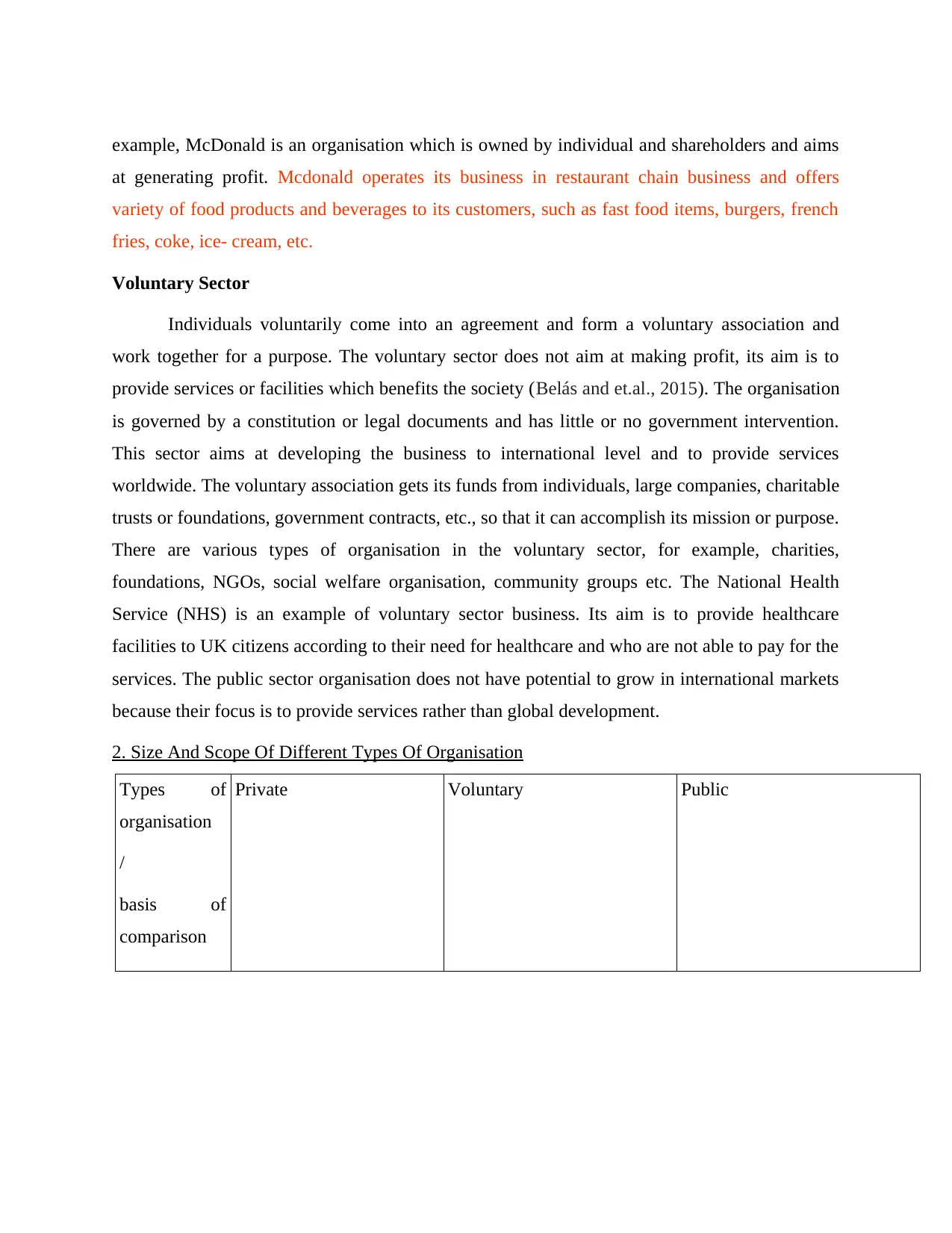
example, McDonald is an organisation which is owned by individual and shareholders and aims
at generating profit. Mcdonald operates its business in restaurant chain business and offers
variety of food products and beverages to its customers, such as fast food items, burgers, french
fries, coke, ice- cream, etc.
Voluntary Sector
Individuals voluntarily come into an agreement and form a voluntary association and
work together for a purpose. The voluntary sector does not aim at making profit, its aim is to
provide services or facilities which benefits the society (Belás and et.al., 2015). The organisation
is governed by a constitution or legal documents and has little or no government intervention.
This sector aims at developing the business to international level and to provide services
worldwide. The voluntary association gets its funds from individuals, large companies, charitable
trusts or foundations, government contracts, etc., so that it can accomplish its mission or purpose.
There are various types of organisation in the voluntary sector, for example, charities,
foundations, NGOs, social welfare organisation, community groups etc. The National Health
Service (NHS) is an example of voluntary sector business. Its aim is to provide healthcare
facilities to UK citizens according to their need for healthcare and who are not able to pay for the
services. The public sector organisation does not have potential to grow in international markets
because their focus is to provide services rather than global development.
2. Size And Scope Of Different Types Of Organisation
Types of
organisation
/
basis of
comparison
Private Voluntary Public
at generating profit. Mcdonald operates its business in restaurant chain business and offers
variety of food products and beverages to its customers, such as fast food items, burgers, french
fries, coke, ice- cream, etc.
Voluntary Sector
Individuals voluntarily come into an agreement and form a voluntary association and
work together for a purpose. The voluntary sector does not aim at making profit, its aim is to
provide services or facilities which benefits the society (Belás and et.al., 2015). The organisation
is governed by a constitution or legal documents and has little or no government intervention.
This sector aims at developing the business to international level and to provide services
worldwide. The voluntary association gets its funds from individuals, large companies, charitable
trusts or foundations, government contracts, etc., so that it can accomplish its mission or purpose.
There are various types of organisation in the voluntary sector, for example, charities,
foundations, NGOs, social welfare organisation, community groups etc. The National Health
Service (NHS) is an example of voluntary sector business. Its aim is to provide healthcare
facilities to UK citizens according to their need for healthcare and who are not able to pay for the
services. The public sector organisation does not have potential to grow in international markets
because their focus is to provide services rather than global development.
2. Size And Scope Of Different Types Of Organisation
Types of
organisation
/
basis of
comparison
Private Voluntary Public
Secure Best Marks with AI Grader
Need help grading? Try our AI Grader for instant feedback on your assignments.
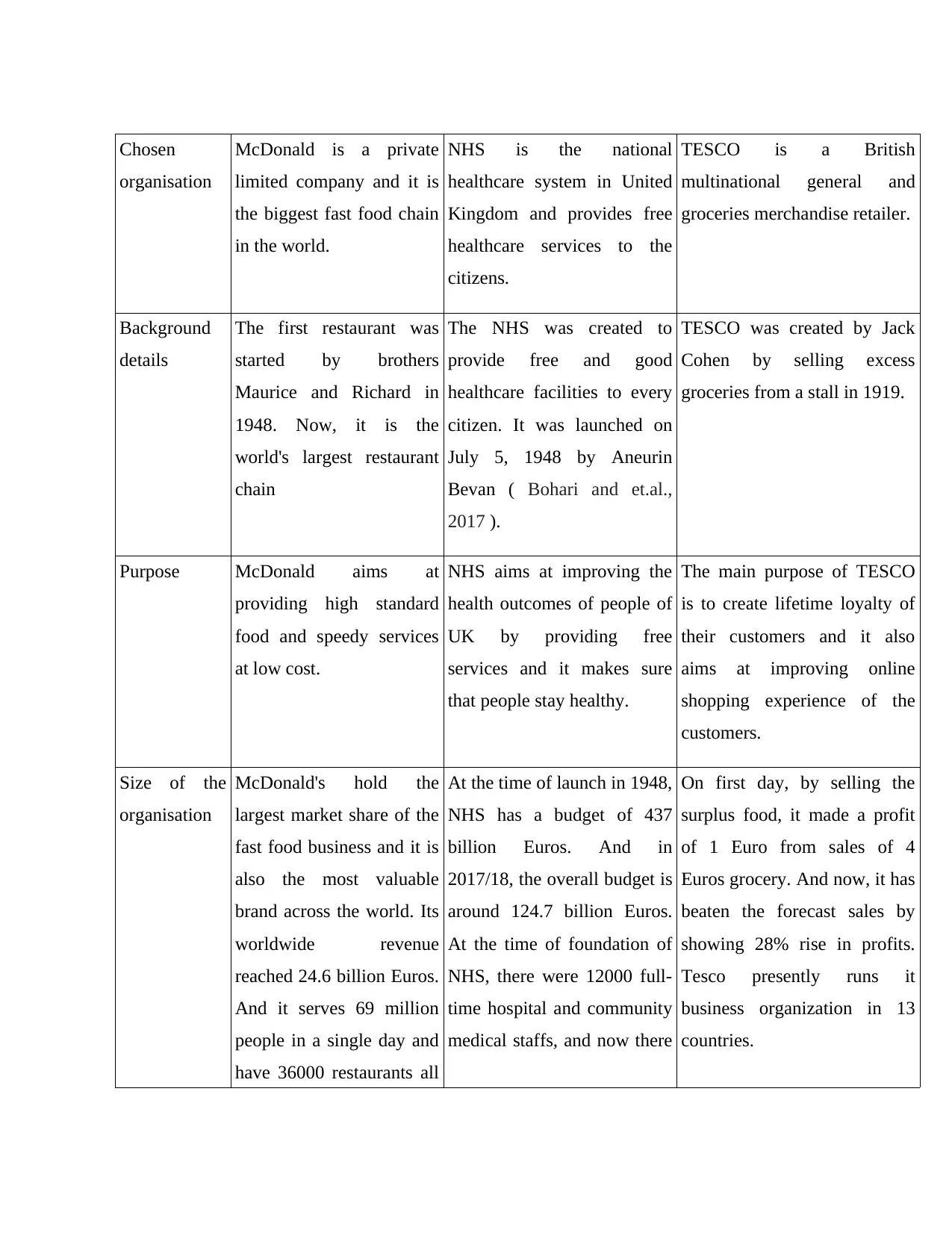
Chosen
organisation
McDonald is a private
limited company and it is
the biggest fast food chain
in the world.
NHS is the national
healthcare system in United
Kingdom and provides free
healthcare services to the
citizens.
TESCO is a British
multinational general and
groceries merchandise retailer.
Background
details
The first restaurant was
started by brothers
Maurice and Richard in
1948. Now, it is the
world's largest restaurant
chain
The NHS was created to
provide free and good
healthcare facilities to every
citizen. It was launched on
July 5, 1948 by Aneurin
Bevan ( Bohari and et.al.,
2017 ).
TESCO was created by Jack
Cohen by selling excess
groceries from a stall in 1919.
Purpose McDonald aims at
providing high standard
food and speedy services
at low cost.
NHS aims at improving the
health outcomes of people of
UK by providing free
services and it makes sure
that people stay healthy.
The main purpose of TESCO
is to create lifetime loyalty of
their customers and it also
aims at improving online
shopping experience of the
customers.
Size of the
organisation
McDonald's hold the
largest market share of the
fast food business and it is
also the most valuable
brand across the world. Its
worldwide revenue
reached 24.6 billion Euros.
And it serves 69 million
people in a single day and
have 36000 restaurants all
At the time of launch in 1948,
NHS has a budget of 437
billion Euros. And in
2017/18, the overall budget is
around 124.7 billion Euros.
At the time of foundation of
NHS, there were 12000 full-
time hospital and community
medical staffs, and now there
On first day, by selling the
surplus food, it made a profit
of 1 Euro from sales of 4
Euros grocery. And now, it has
beaten the forecast sales by
showing 28% rise in profits.
Tesco presently runs it
business organization in 13
countries.
organisation
McDonald is a private
limited company and it is
the biggest fast food chain
in the world.
NHS is the national
healthcare system in United
Kingdom and provides free
healthcare services to the
citizens.
TESCO is a British
multinational general and
groceries merchandise retailer.
Background
details
The first restaurant was
started by brothers
Maurice and Richard in
1948. Now, it is the
world's largest restaurant
chain
The NHS was created to
provide free and good
healthcare facilities to every
citizen. It was launched on
July 5, 1948 by Aneurin
Bevan ( Bohari and et.al.,
2017 ).
TESCO was created by Jack
Cohen by selling excess
groceries from a stall in 1919.
Purpose McDonald aims at
providing high standard
food and speedy services
at low cost.
NHS aims at improving the
health outcomes of people of
UK by providing free
services and it makes sure
that people stay healthy.
The main purpose of TESCO
is to create lifetime loyalty of
their customers and it also
aims at improving online
shopping experience of the
customers.
Size of the
organisation
McDonald's hold the
largest market share of the
fast food business and it is
also the most valuable
brand across the world. Its
worldwide revenue
reached 24.6 billion Euros.
And it serves 69 million
people in a single day and
have 36000 restaurants all
At the time of launch in 1948,
NHS has a budget of 437
billion Euros. And in
2017/18, the overall budget is
around 124.7 billion Euros.
At the time of foundation of
NHS, there were 12000 full-
time hospital and community
medical staffs, and now there
On first day, by selling the
surplus food, it made a profit
of 1 Euro from sales of 4
Euros grocery. And now, it has
beaten the forecast sales by
showing 28% rise in profits.
Tesco presently runs it
business organization in 13
countries.
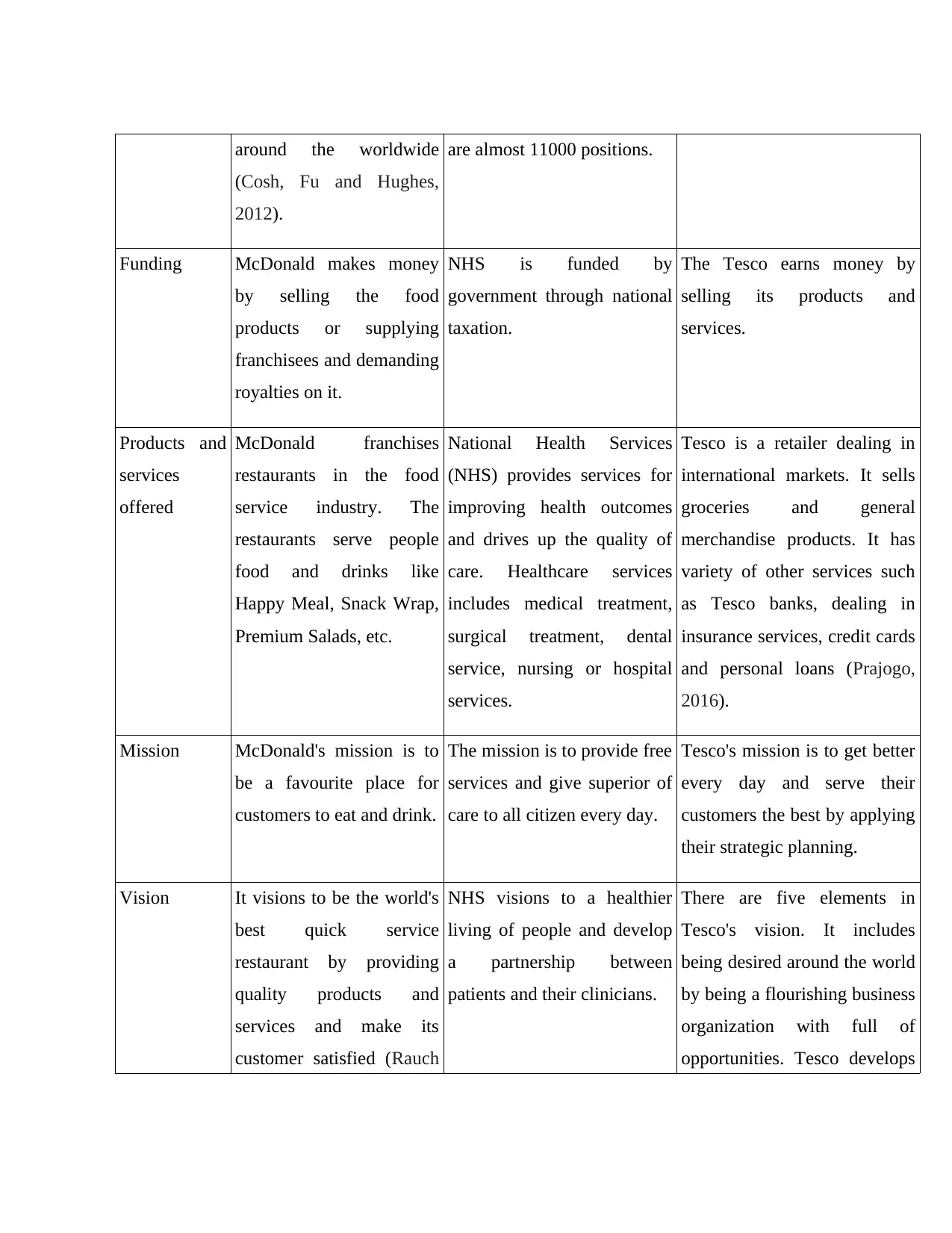
around the worldwide
(Cosh, Fu and Hughes,
2012).
are almost 11000 positions.
Funding McDonald makes money
by selling the food
products or supplying
franchisees and demanding
royalties on it.
NHS is funded by
government through national
taxation.
The Tesco earns money by
selling its products and
services.
Products and
services
offered
McDonald franchises
restaurants in the food
service industry. The
restaurants serve people
food and drinks like
Happy Meal, Snack Wrap,
Premium Salads, etc.
National Health Services
(NHS) provides services for
improving health outcomes
and drives up the quality of
care. Healthcare services
includes medical treatment,
surgical treatment, dental
service, nursing or hospital
services.
Tesco is a retailer dealing in
international markets. It sells
groceries and general
merchandise products. It has
variety of other services such
as Tesco banks, dealing in
insurance services, credit cards
and personal loans (Prajogo,
2016).
Mission McDonald's mission is to
be a favourite place for
customers to eat and drink.
The mission is to provide free
services and give superior of
care to all citizen every day.
Tesco's mission is to get better
every day and serve their
customers the best by applying
their strategic planning.
Vision It visions to be the world's
best quick service
restaurant by providing
quality products and
services and make its
customer satisfied (Rauch
NHS visions to a healthier
living of people and develop
a partnership between
patients and their clinicians.
There are five elements in
Tesco's vision. It includes
being desired around the world
by being a flourishing business
organization with full of
opportunities. Tesco develops
(Cosh, Fu and Hughes,
2012).
are almost 11000 positions.
Funding McDonald makes money
by selling the food
products or supplying
franchisees and demanding
royalties on it.
NHS is funded by
government through national
taxation.
The Tesco earns money by
selling its products and
services.
Products and
services
offered
McDonald franchises
restaurants in the food
service industry. The
restaurants serve people
food and drinks like
Happy Meal, Snack Wrap,
Premium Salads, etc.
National Health Services
(NHS) provides services for
improving health outcomes
and drives up the quality of
care. Healthcare services
includes medical treatment,
surgical treatment, dental
service, nursing or hospital
services.
Tesco is a retailer dealing in
international markets. It sells
groceries and general
merchandise products. It has
variety of other services such
as Tesco banks, dealing in
insurance services, credit cards
and personal loans (Prajogo,
2016).
Mission McDonald's mission is to
be a favourite place for
customers to eat and drink.
The mission is to provide free
services and give superior of
care to all citizen every day.
Tesco's mission is to get better
every day and serve their
customers the best by applying
their strategic planning.
Vision It visions to be the world's
best quick service
restaurant by providing
quality products and
services and make its
customer satisfied (Rauch
NHS visions to a healthier
living of people and develop
a partnership between
patients and their clinicians.
There are five elements in
Tesco's vision. It includes
being desired around the world
by being a flourishing business
organization with full of
opportunities. Tesco develops
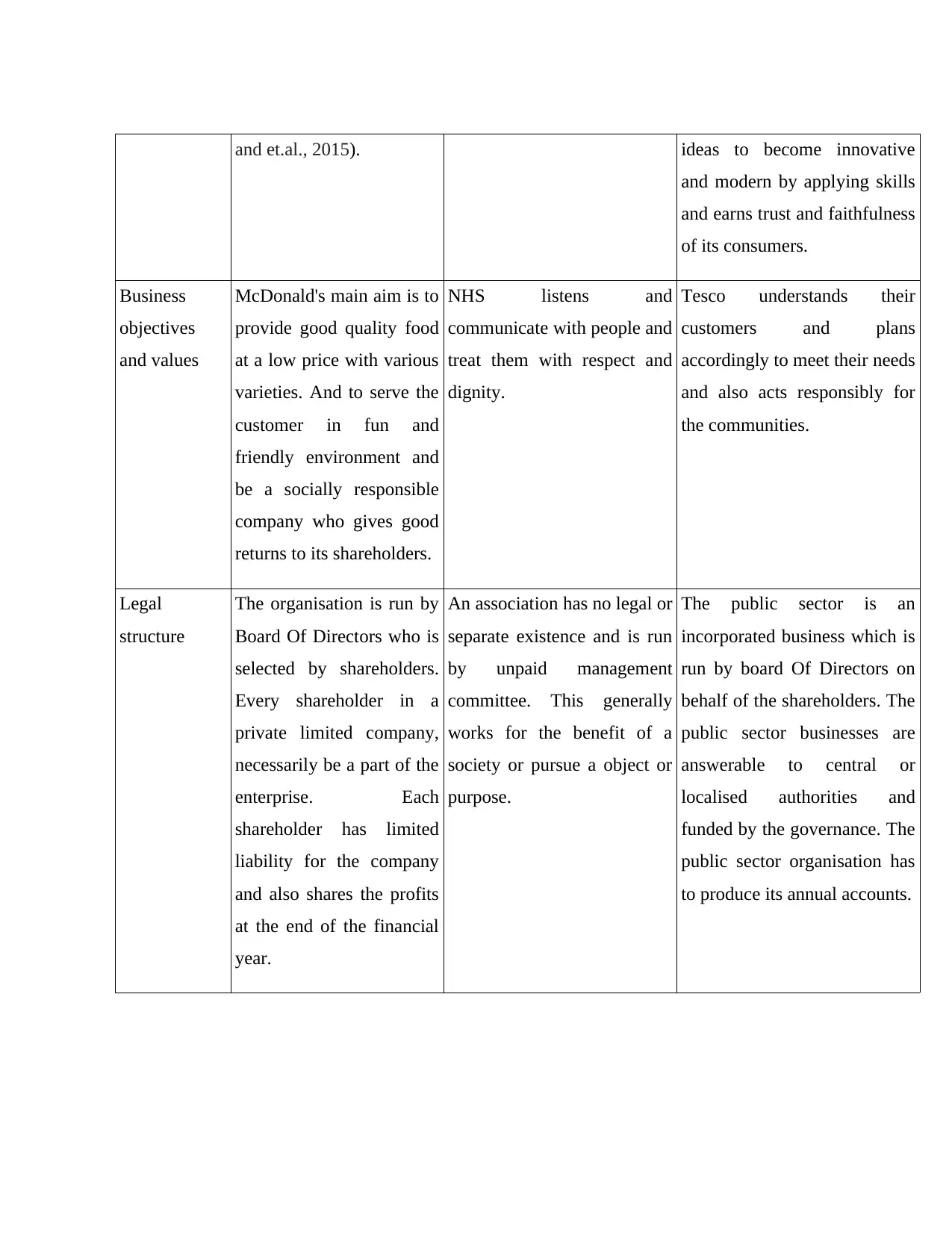
and et.al., 2015). ideas to become innovative
and modern by applying skills
and earns trust and faithfulness
of its consumers.
Business
objectives
and values
McDonald's main aim is to
provide good quality food
at a low price with various
varieties. And to serve the
customer in fun and
friendly environment and
be a socially responsible
company who gives good
returns to its shareholders.
NHS listens and
communicate with people and
treat them with respect and
dignity.
Tesco understands their
customers and plans
accordingly to meet their needs
and also acts responsibly for
the communities.
Legal
structure
The organisation is run by
Board Of Directors who is
selected by shareholders.
Every shareholder in a
private limited company,
necessarily be a part of the
enterprise. Each
shareholder has limited
liability for the company
and also shares the profits
at the end of the financial
year.
An association has no legal or
separate existence and is run
by unpaid management
committee. This generally
works for the benefit of a
society or pursue a object or
purpose.
The public sector is an
incorporated business which is
run by board Of Directors on
behalf of the shareholders. The
public sector businesses are
answerable to central or
localised authorities and
funded by the governance. The
public sector organisation has
to produce its annual accounts.
and modern by applying skills
and earns trust and faithfulness
of its consumers.
Business
objectives
and values
McDonald's main aim is to
provide good quality food
at a low price with various
varieties. And to serve the
customer in fun and
friendly environment and
be a socially responsible
company who gives good
returns to its shareholders.
NHS listens and
communicate with people and
treat them with respect and
dignity.
Tesco understands their
customers and plans
accordingly to meet their needs
and also acts responsibly for
the communities.
Legal
structure
The organisation is run by
Board Of Directors who is
selected by shareholders.
Every shareholder in a
private limited company,
necessarily be a part of the
enterprise. Each
shareholder has limited
liability for the company
and also shares the profits
at the end of the financial
year.
An association has no legal or
separate existence and is run
by unpaid management
committee. This generally
works for the benefit of a
society or pursue a object or
purpose.
The public sector is an
incorporated business which is
run by board Of Directors on
behalf of the shareholders. The
public sector businesses are
answerable to central or
localised authorities and
funded by the governance. The
public sector organisation has
to produce its annual accounts.
Paraphrase This Document
Need a fresh take? Get an instant paraphrase of this document with our AI Paraphraser
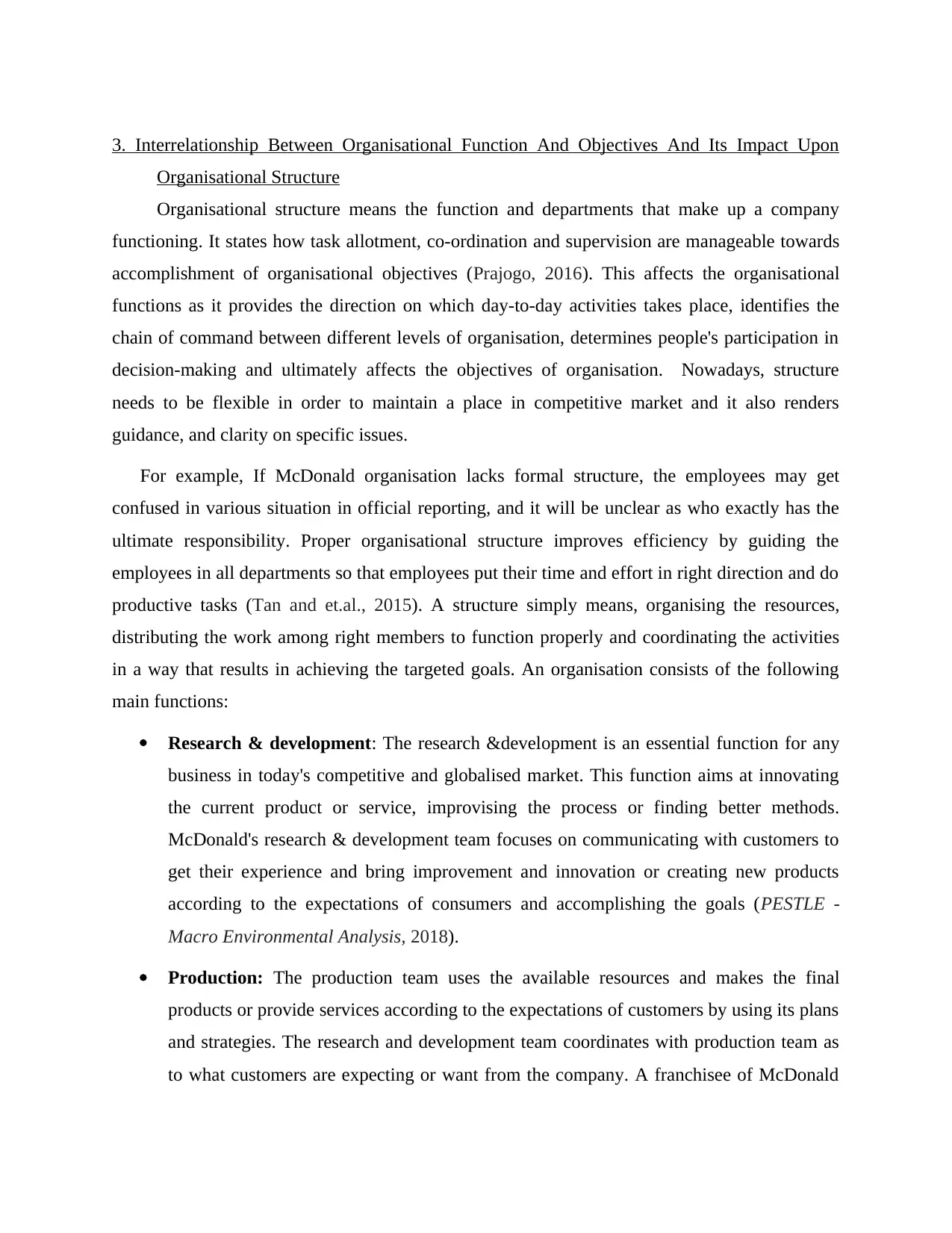
3. Interrelationship Between Organisational Function And Objectives And Its Impact Upon
Organisational Structure
Organisational structure means the function and departments that make up a company
functioning. It states how task allotment, co-ordination and supervision are manageable towards
accomplishment of organisational objectives (Prajogo, 2016). This affects the organisational
functions as it provides the direction on which day-to-day activities takes place, identifies the
chain of command between different levels of organisation, determines people's participation in
decision-making and ultimately affects the objectives of organisation. Nowadays, structure
needs to be flexible in order to maintain a place in competitive market and it also renders
guidance, and clarity on specific issues.
For example, If McDonald organisation lacks formal structure, the employees may get
confused in various situation in official reporting, and it will be unclear as who exactly has the
ultimate responsibility. Proper organisational structure improves efficiency by guiding the
employees in all departments so that employees put their time and effort in right direction and do
productive tasks (Tan and et.al., 2015). A structure simply means, organising the resources,
distributing the work among right members to function properly and coordinating the activities
in a way that results in achieving the targeted goals. An organisation consists of the following
main functions:
Research & development: The research &development is an essential function for any
business in today's competitive and globalised market. This function aims at innovating
the current product or service, improvising the process or finding better methods.
McDonald's research & development team focuses on communicating with customers to
get their experience and bring improvement and innovation or creating new products
according to the expectations of consumers and accomplishing the goals (PESTLE -
Macro Environmental Analysis, 2018).
Production: The production team uses the available resources and makes the final
products or provide services according to the expectations of customers by using its plans
and strategies. The research and development team coordinates with production team as
to what customers are expecting or want from the company. A franchisee of McDonald
Organisational Structure
Organisational structure means the function and departments that make up a company
functioning. It states how task allotment, co-ordination and supervision are manageable towards
accomplishment of organisational objectives (Prajogo, 2016). This affects the organisational
functions as it provides the direction on which day-to-day activities takes place, identifies the
chain of command between different levels of organisation, determines people's participation in
decision-making and ultimately affects the objectives of organisation. Nowadays, structure
needs to be flexible in order to maintain a place in competitive market and it also renders
guidance, and clarity on specific issues.
For example, If McDonald organisation lacks formal structure, the employees may get
confused in various situation in official reporting, and it will be unclear as who exactly has the
ultimate responsibility. Proper organisational structure improves efficiency by guiding the
employees in all departments so that employees put their time and effort in right direction and do
productive tasks (Tan and et.al., 2015). A structure simply means, organising the resources,
distributing the work among right members to function properly and coordinating the activities
in a way that results in achieving the targeted goals. An organisation consists of the following
main functions:
Research & development: The research &development is an essential function for any
business in today's competitive and globalised market. This function aims at innovating
the current product or service, improvising the process or finding better methods.
McDonald's research & development team focuses on communicating with customers to
get their experience and bring improvement and innovation or creating new products
according to the expectations of consumers and accomplishing the goals (PESTLE -
Macro Environmental Analysis, 2018).
Production: The production team uses the available resources and makes the final
products or provide services according to the expectations of customers by using its plans
and strategies. The research and development team coordinates with production team as
to what customers are expecting or want from the company. A franchisee of McDonald
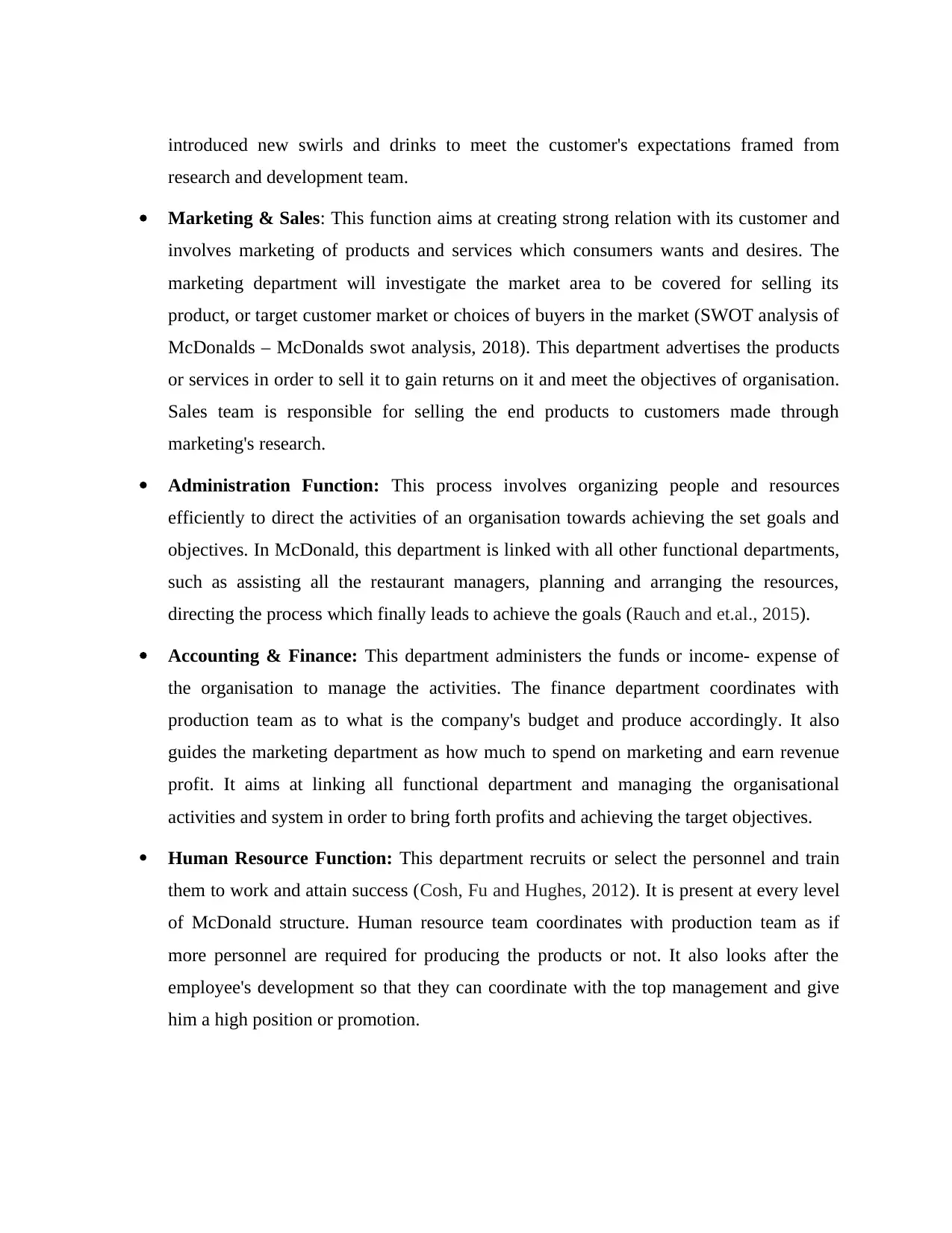
introduced new swirls and drinks to meet the customer's expectations framed from
research and development team.
Marketing & Sales: This function aims at creating strong relation with its customer and
involves marketing of products and services which consumers wants and desires. The
marketing department will investigate the market area to be covered for selling its
product, or target customer market or choices of buyers in the market (SWOT analysis of
McDonalds – McDonalds swot analysis, 2018). This department advertises the products
or services in order to sell it to gain returns on it and meet the objectives of organisation.
Sales team is responsible for selling the end products to customers made through
marketing's research.
Administration Function: This process involves organizing people and resources
efficiently to direct the activities of an organisation towards achieving the set goals and
objectives. In McDonald, this department is linked with all other functional departments,
such as assisting all the restaurant managers, planning and arranging the resources,
directing the process which finally leads to achieve the goals (Rauch and et.al., 2015).
Accounting & Finance: This department administers the funds or income- expense of
the organisation to manage the activities. The finance department coordinates with
production team as to what is the company's budget and produce accordingly. It also
guides the marketing department as how much to spend on marketing and earn revenue
profit. It aims at linking all functional department and managing the organisational
activities and system in order to bring forth profits and achieving the target objectives.
Human Resource Function: This department recruits or select the personnel and train
them to work and attain success (Cosh, Fu and Hughes, 2012). It is present at every level
of McDonald structure. Human resource team coordinates with production team as if
more personnel are required for producing the products or not. It also looks after the
employee's development so that they can coordinate with the top management and give
him a high position or promotion.
research and development team.
Marketing & Sales: This function aims at creating strong relation with its customer and
involves marketing of products and services which consumers wants and desires. The
marketing department will investigate the market area to be covered for selling its
product, or target customer market or choices of buyers in the market (SWOT analysis of
McDonalds – McDonalds swot analysis, 2018). This department advertises the products
or services in order to sell it to gain returns on it and meet the objectives of organisation.
Sales team is responsible for selling the end products to customers made through
marketing's research.
Administration Function: This process involves organizing people and resources
efficiently to direct the activities of an organisation towards achieving the set goals and
objectives. In McDonald, this department is linked with all other functional departments,
such as assisting all the restaurant managers, planning and arranging the resources,
directing the process which finally leads to achieve the goals (Rauch and et.al., 2015).
Accounting & Finance: This department administers the funds or income- expense of
the organisation to manage the activities. The finance department coordinates with
production team as to what is the company's budget and produce accordingly. It also
guides the marketing department as how much to spend on marketing and earn revenue
profit. It aims at linking all functional department and managing the organisational
activities and system in order to bring forth profits and achieving the target objectives.
Human Resource Function: This department recruits or select the personnel and train
them to work and attain success (Cosh, Fu and Hughes, 2012). It is present at every level
of McDonald structure. Human resource team coordinates with production team as if
more personnel are required for producing the products or not. It also looks after the
employee's development so that they can coordinate with the top management and give
him a high position or promotion.
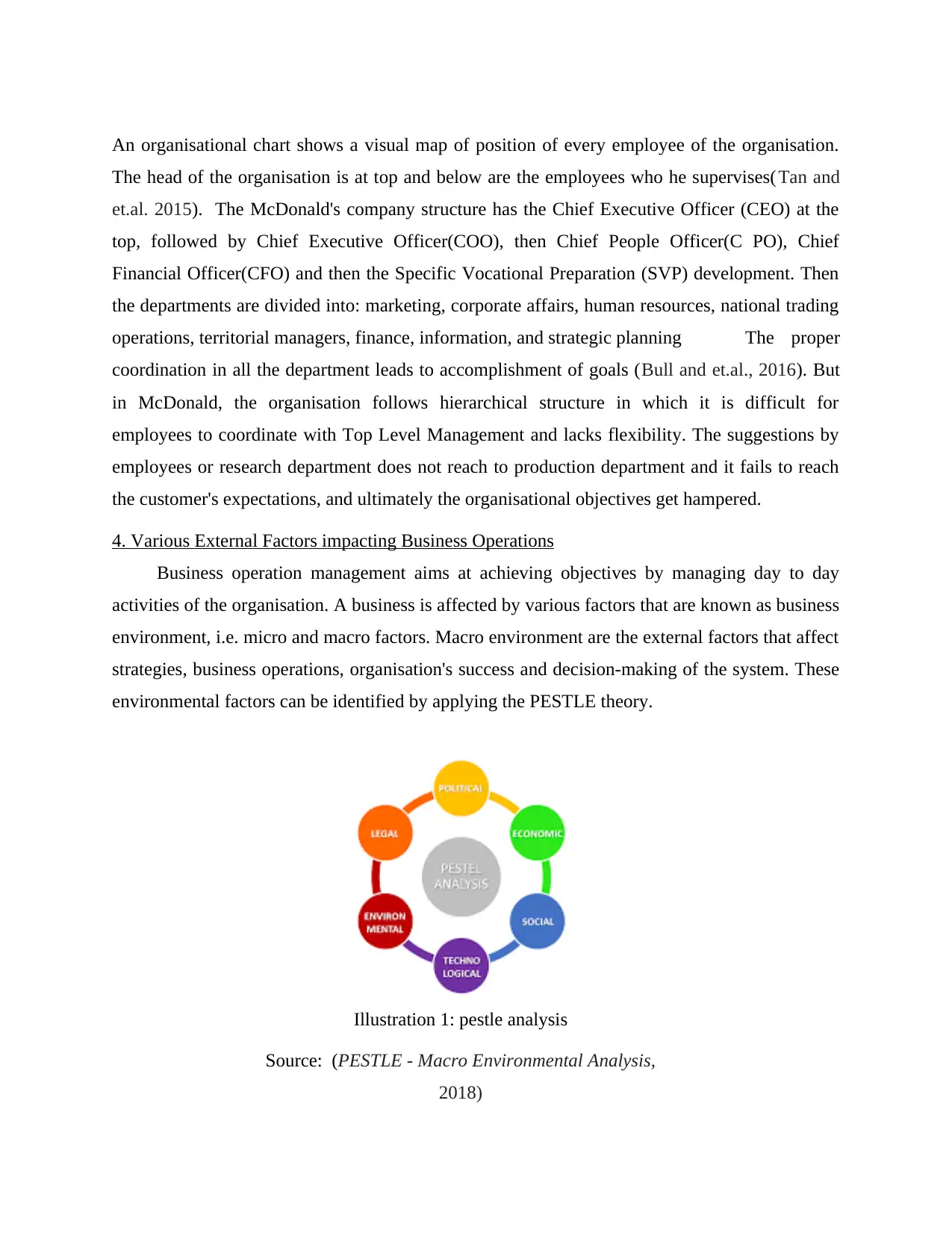
An organisational chart shows a visual map of position of every employee of the organisation.
The head of the organisation is at top and below are the employees who he supervises( Tan and
et.al. 2015). The McDonald's company structure has the Chief Executive Officer (CEO) at the
top, followed by Chief Executive Officer(COO), then Chief People Officer(C PO), Chief
Financial Officer(CFO) and then the Specific Vocational Preparation (SVP) development. Then
the departments are divided into: marketing, corporate affairs, human resources, national trading
operations, territorial managers, finance, information, and strategic planning The proper
coordination in all the department leads to accomplishment of goals (Bull and et.al., 2016). But
in McDonald, the organisation follows hierarchical structure in which it is difficult for
employees to coordinate with Top Level Management and lacks flexibility. The suggestions by
employees or research department does not reach to production department and it fails to reach
the customer's expectations, and ultimately the organisational objectives get hampered.
4. Various External Factors impacting Business Operations
Business operation management aims at achieving objectives by managing day to day
activities of the organisation. A business is affected by various factors that are known as business
environment, i.e. micro and macro factors. Macro environment are the external factors that affect
strategies, business operations, organisation's success and decision-making of the system. These
environmental factors can be identified by applying the PESTLE theory.
Illustration 1: pestle analysis
Source: (PESTLE - Macro Environmental Analysis,
2018)
The head of the organisation is at top and below are the employees who he supervises( Tan and
et.al. 2015). The McDonald's company structure has the Chief Executive Officer (CEO) at the
top, followed by Chief Executive Officer(COO), then Chief People Officer(C PO), Chief
Financial Officer(CFO) and then the Specific Vocational Preparation (SVP) development. Then
the departments are divided into: marketing, corporate affairs, human resources, national trading
operations, territorial managers, finance, information, and strategic planning The proper
coordination in all the department leads to accomplishment of goals (Bull and et.al., 2016). But
in McDonald, the organisation follows hierarchical structure in which it is difficult for
employees to coordinate with Top Level Management and lacks flexibility. The suggestions by
employees or research department does not reach to production department and it fails to reach
the customer's expectations, and ultimately the organisational objectives get hampered.
4. Various External Factors impacting Business Operations
Business operation management aims at achieving objectives by managing day to day
activities of the organisation. A business is affected by various factors that are known as business
environment, i.e. micro and macro factors. Macro environment are the external factors that affect
strategies, business operations, organisation's success and decision-making of the system. These
environmental factors can be identified by applying the PESTLE theory.
Illustration 1: pestle analysis
Source: (PESTLE - Macro Environmental Analysis,
2018)
Secure Best Marks with AI Grader
Need help grading? Try our AI Grader for instant feedback on your assignments.
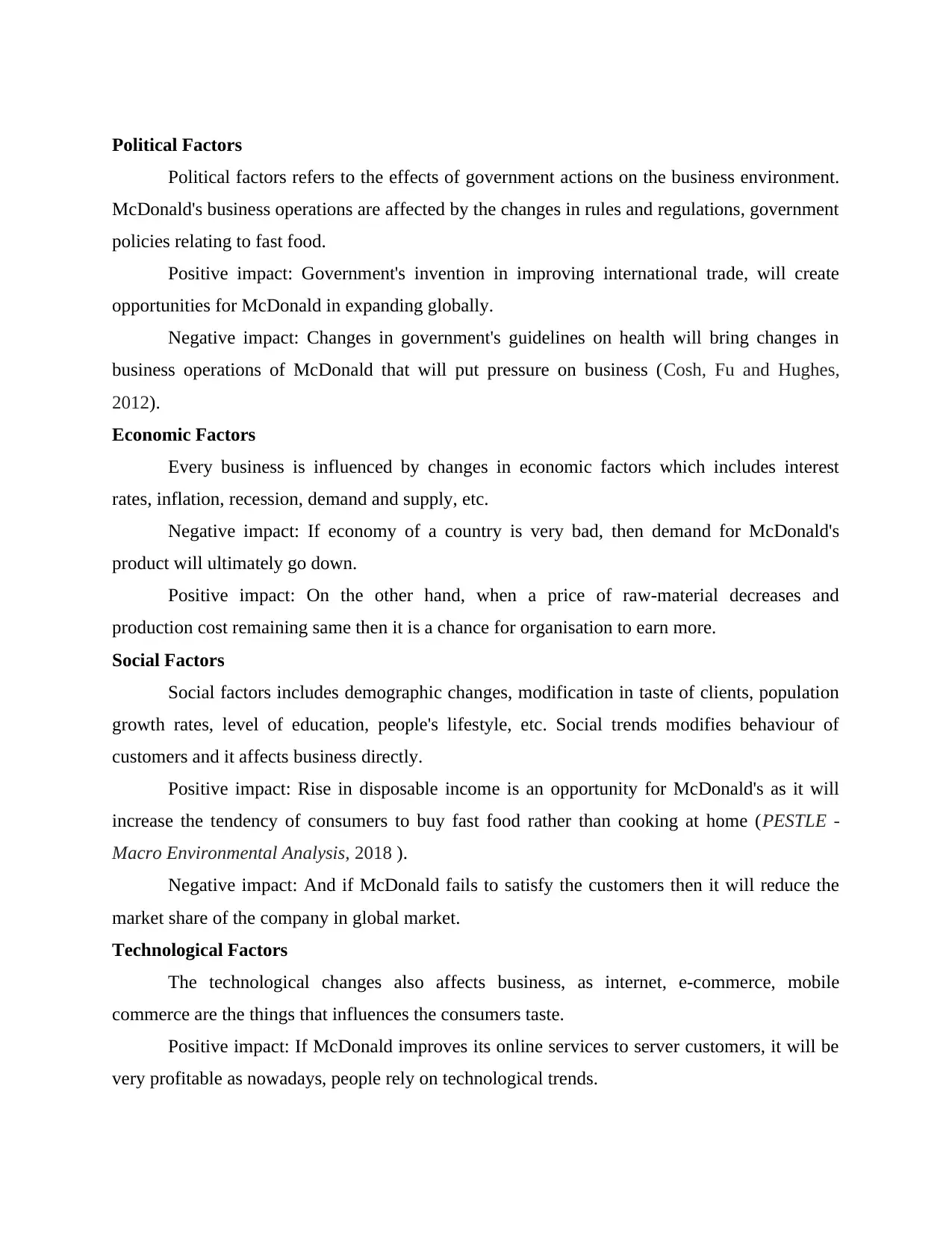
Political Factors
Political factors refers to the effects of government actions on the business environment.
McDonald's business operations are affected by the changes in rules and regulations, government
policies relating to fast food.
Positive impact: Government's invention in improving international trade, will create
opportunities for McDonald in expanding globally.
Negative impact: Changes in government's guidelines on health will bring changes in
business operations of McDonald that will put pressure on business (Cosh, Fu and Hughes,
2012).
Economic Factors
Every business is influenced by changes in economic factors which includes interest
rates, inflation, recession, demand and supply, etc.
Negative impact: If economy of a country is very bad, then demand for McDonald's
product will ultimately go down.
Positive impact: On the other hand, when a price of raw-material decreases and
production cost remaining same then it is a chance for organisation to earn more.
Social Factors
Social factors includes demographic changes, modification in taste of clients, population
growth rates, level of education, people's lifestyle, etc. Social trends modifies behaviour of
customers and it affects business directly.
Positive impact: Rise in disposable income is an opportunity for McDonald's as it will
increase the tendency of consumers to buy fast food rather than cooking at home (PESTLE -
Macro Environmental Analysis, 2018 ).
Negative impact: And if McDonald fails to satisfy the customers then it will reduce the
market share of the company in global market.
Technological Factors
The technological changes also affects business, as internet, e-commerce, mobile
commerce are the things that influences the consumers taste.
Positive impact: If McDonald improves its online services to server customers, it will be
very profitable as nowadays, people rely on technological trends.
Political factors refers to the effects of government actions on the business environment.
McDonald's business operations are affected by the changes in rules and regulations, government
policies relating to fast food.
Positive impact: Government's invention in improving international trade, will create
opportunities for McDonald in expanding globally.
Negative impact: Changes in government's guidelines on health will bring changes in
business operations of McDonald that will put pressure on business (Cosh, Fu and Hughes,
2012).
Economic Factors
Every business is influenced by changes in economic factors which includes interest
rates, inflation, recession, demand and supply, etc.
Negative impact: If economy of a country is very bad, then demand for McDonald's
product will ultimately go down.
Positive impact: On the other hand, when a price of raw-material decreases and
production cost remaining same then it is a chance for organisation to earn more.
Social Factors
Social factors includes demographic changes, modification in taste of clients, population
growth rates, level of education, people's lifestyle, etc. Social trends modifies behaviour of
customers and it affects business directly.
Positive impact: Rise in disposable income is an opportunity for McDonald's as it will
increase the tendency of consumers to buy fast food rather than cooking at home (PESTLE -
Macro Environmental Analysis, 2018 ).
Negative impact: And if McDonald fails to satisfy the customers then it will reduce the
market share of the company in global market.
Technological Factors
The technological changes also affects business, as internet, e-commerce, mobile
commerce are the things that influences the consumers taste.
Positive impact: If McDonald improves its online services to server customers, it will be
very profitable as nowadays, people rely on technological trends.
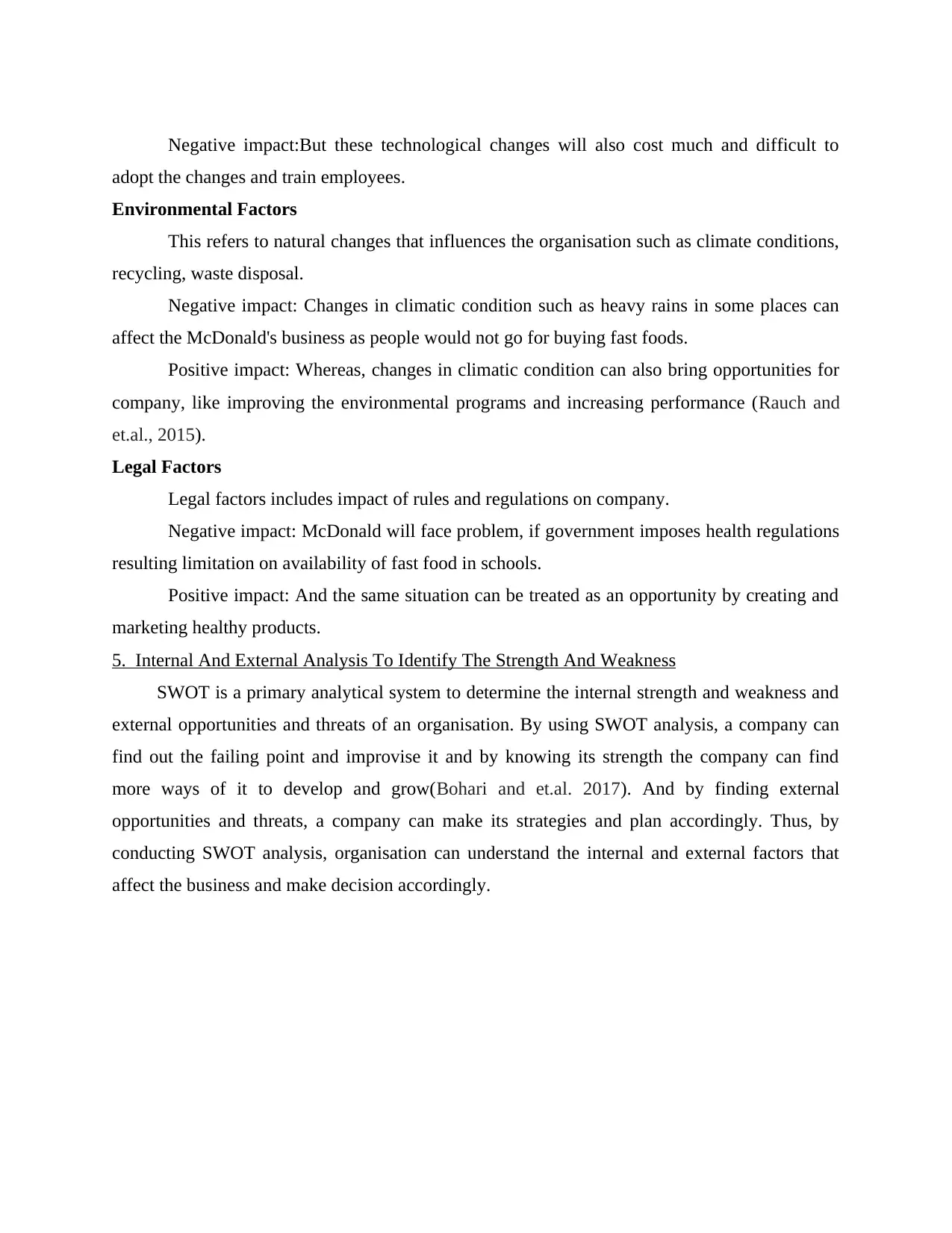
Negative impact:But these technological changes will also cost much and difficult to
adopt the changes and train employees.
Environmental Factors
This refers to natural changes that influences the organisation such as climate conditions,
recycling, waste disposal.
Negative impact: Changes in climatic condition such as heavy rains in some places can
affect the McDonald's business as people would not go for buying fast foods.
Positive impact: Whereas, changes in climatic condition can also bring opportunities for
company, like improving the environmental programs and increasing performance (Rauch and
et.al., 2015).
Legal Factors
Legal factors includes impact of rules and regulations on company.
Negative impact: McDonald will face problem, if government imposes health regulations
resulting limitation on availability of fast food in schools.
Positive impact: And the same situation can be treated as an opportunity by creating and
marketing healthy products.
5. Internal And External Analysis To Identify The Strength And Weakness
SWOT is a primary analytical system to determine the internal strength and weakness and
external opportunities and threats of an organisation. By using SWOT analysis, a company can
find out the failing point and improvise it and by knowing its strength the company can find
more ways of it to develop and grow(Bohari and et.al. 2017). And by finding external
opportunities and threats, a company can make its strategies and plan accordingly. Thus, by
conducting SWOT analysis, organisation can understand the internal and external factors that
affect the business and make decision accordingly.
adopt the changes and train employees.
Environmental Factors
This refers to natural changes that influences the organisation such as climate conditions,
recycling, waste disposal.
Negative impact: Changes in climatic condition such as heavy rains in some places can
affect the McDonald's business as people would not go for buying fast foods.
Positive impact: Whereas, changes in climatic condition can also bring opportunities for
company, like improving the environmental programs and increasing performance (Rauch and
et.al., 2015).
Legal Factors
Legal factors includes impact of rules and regulations on company.
Negative impact: McDonald will face problem, if government imposes health regulations
resulting limitation on availability of fast food in schools.
Positive impact: And the same situation can be treated as an opportunity by creating and
marketing healthy products.
5. Internal And External Analysis To Identify The Strength And Weakness
SWOT is a primary analytical system to determine the internal strength and weakness and
external opportunities and threats of an organisation. By using SWOT analysis, a company can
find out the failing point and improvise it and by knowing its strength the company can find
more ways of it to develop and grow(Bohari and et.al. 2017). And by finding external
opportunities and threats, a company can make its strategies and plan accordingly. Thus, by
conducting SWOT analysis, organisation can understand the internal and external factors that
affect the business and make decision accordingly.
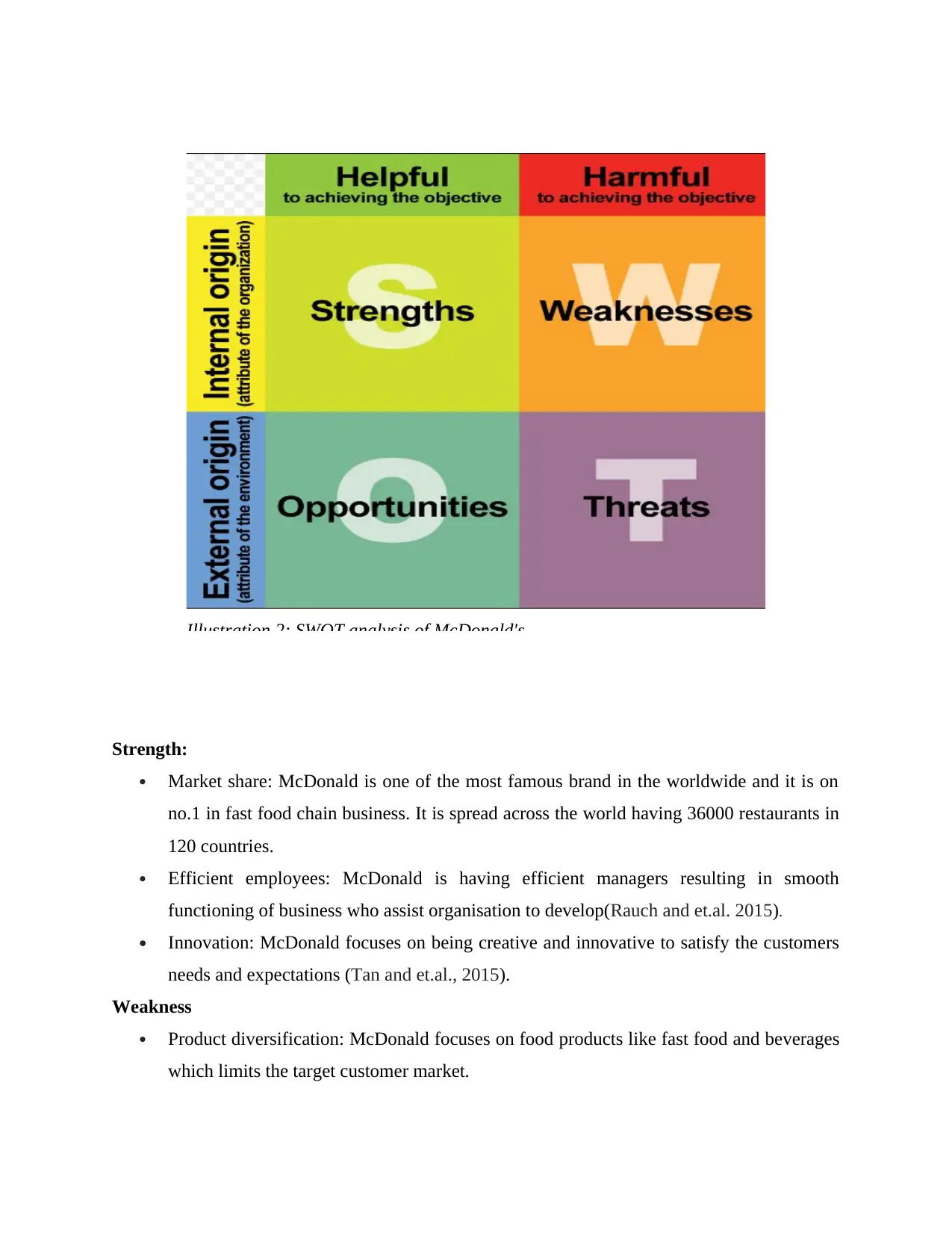
Strength:
Market share: McDonald is one of the most famous brand in the worldwide and it is on
no.1 in fast food chain business. It is spread across the world having 36000 restaurants in
120 countries.
Efficient employees: McDonald is having efficient managers resulting in smooth
functioning of business who assist organisation to develop(Rauch and et.al. 2015).
Innovation: McDonald focuses on being creative and innovative to satisfy the customers
needs and expectations (Tan and et.al., 2015).
Weakness
Product diversification: McDonald focuses on food products like fast food and beverages
which limits the target customer market.
Illustration 2: SWOT analysis of McDonald's
Market share: McDonald is one of the most famous brand in the worldwide and it is on
no.1 in fast food chain business. It is spread across the world having 36000 restaurants in
120 countries.
Efficient employees: McDonald is having efficient managers resulting in smooth
functioning of business who assist organisation to develop(Rauch and et.al. 2015).
Innovation: McDonald focuses on being creative and innovative to satisfy the customers
needs and expectations (Tan and et.al., 2015).
Weakness
Product diversification: McDonald focuses on food products like fast food and beverages
which limits the target customer market.
Illustration 2: SWOT analysis of McDonald's
Paraphrase This Document
Need a fresh take? Get an instant paraphrase of this document with our AI Paraphraser
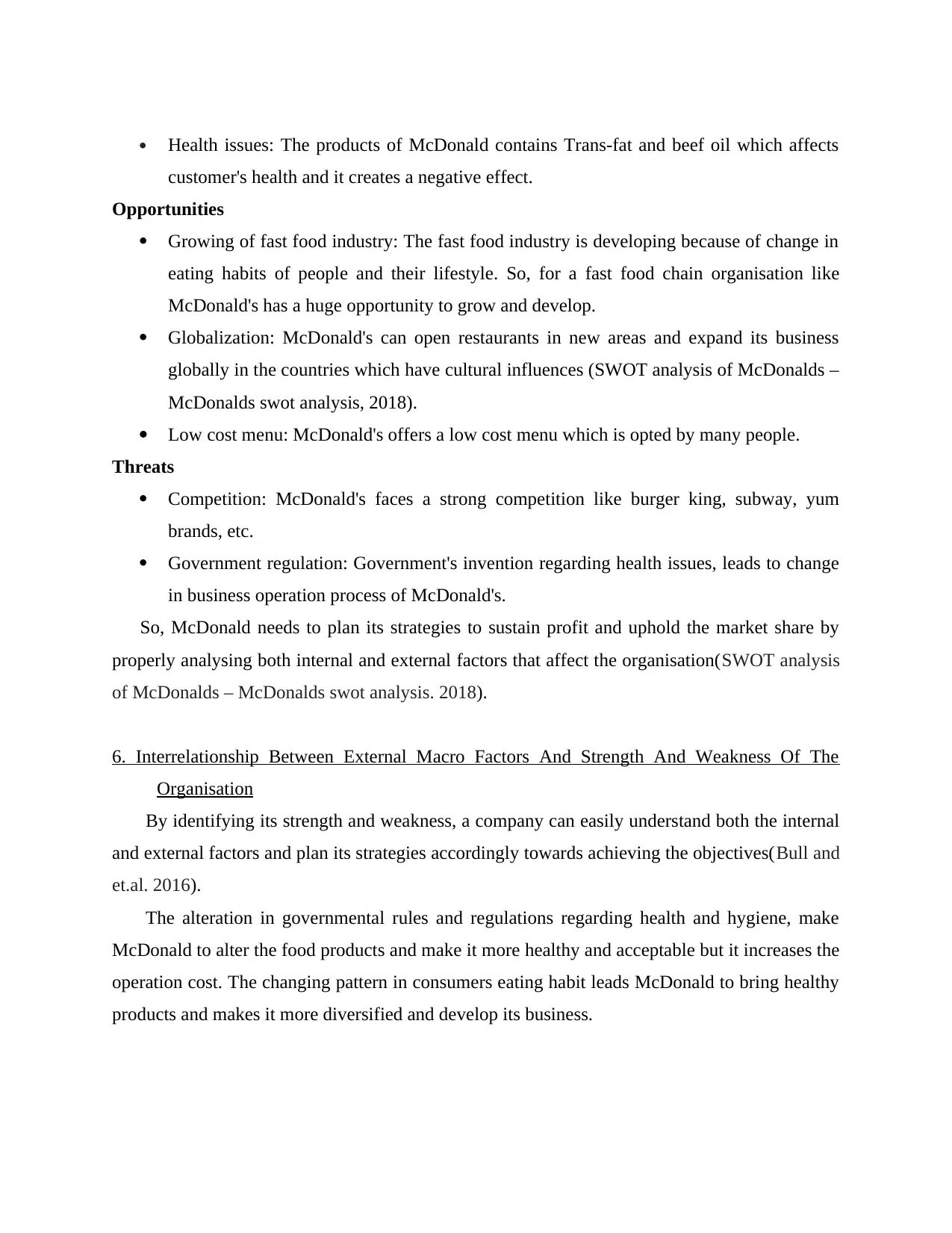
Health issues: The products of McDonald contains Trans-fat and beef oil which affects
customer's health and it creates a negative effect.
Opportunities
Growing of fast food industry: The fast food industry is developing because of change in
eating habits of people and their lifestyle. So, for a fast food chain organisation like
McDonald's has a huge opportunity to grow and develop.
Globalization: McDonald's can open restaurants in new areas and expand its business
globally in the countries which have cultural influences (SWOT analysis of McDonalds –
McDonalds swot analysis, 2018).
Low cost menu: McDonald's offers a low cost menu which is opted by many people.
Threats
Competition: McDonald's faces a strong competition like burger king, subway, yum
brands, etc.
Government regulation: Government's invention regarding health issues, leads to change
in business operation process of McDonald's.
So, McDonald needs to plan its strategies to sustain profit and uphold the market share by
properly analysing both internal and external factors that affect the organisation(SWOT analysis
of McDonalds – McDonalds swot analysis. 2018).
6. Interrelationship Between External Macro Factors And Strength And Weakness Of The
Organisation
By identifying its strength and weakness, a company can easily understand both the internal
and external factors and plan its strategies accordingly towards achieving the objectives(Bull and
et.al. 2016).
The alteration in governmental rules and regulations regarding health and hygiene, make
McDonald to alter the food products and make it more healthy and acceptable but it increases the
operation cost. The changing pattern in consumers eating habit leads McDonald to bring healthy
products and makes it more diversified and develop its business.
customer's health and it creates a negative effect.
Opportunities
Growing of fast food industry: The fast food industry is developing because of change in
eating habits of people and their lifestyle. So, for a fast food chain organisation like
McDonald's has a huge opportunity to grow and develop.
Globalization: McDonald's can open restaurants in new areas and expand its business
globally in the countries which have cultural influences (SWOT analysis of McDonalds –
McDonalds swot analysis, 2018).
Low cost menu: McDonald's offers a low cost menu which is opted by many people.
Threats
Competition: McDonald's faces a strong competition like burger king, subway, yum
brands, etc.
Government regulation: Government's invention regarding health issues, leads to change
in business operation process of McDonald's.
So, McDonald needs to plan its strategies to sustain profit and uphold the market share by
properly analysing both internal and external factors that affect the organisation(SWOT analysis
of McDonalds – McDonalds swot analysis. 2018).
6. Interrelationship Between External Macro Factors And Strength And Weakness Of The
Organisation
By identifying its strength and weakness, a company can easily understand both the internal
and external factors and plan its strategies accordingly towards achieving the objectives(Bull and
et.al. 2016).
The alteration in governmental rules and regulations regarding health and hygiene, make
McDonald to alter the food products and make it more healthy and acceptable but it increases the
operation cost. The changing pattern in consumers eating habit leads McDonald to bring healthy
products and makes it more diversified and develop its business.
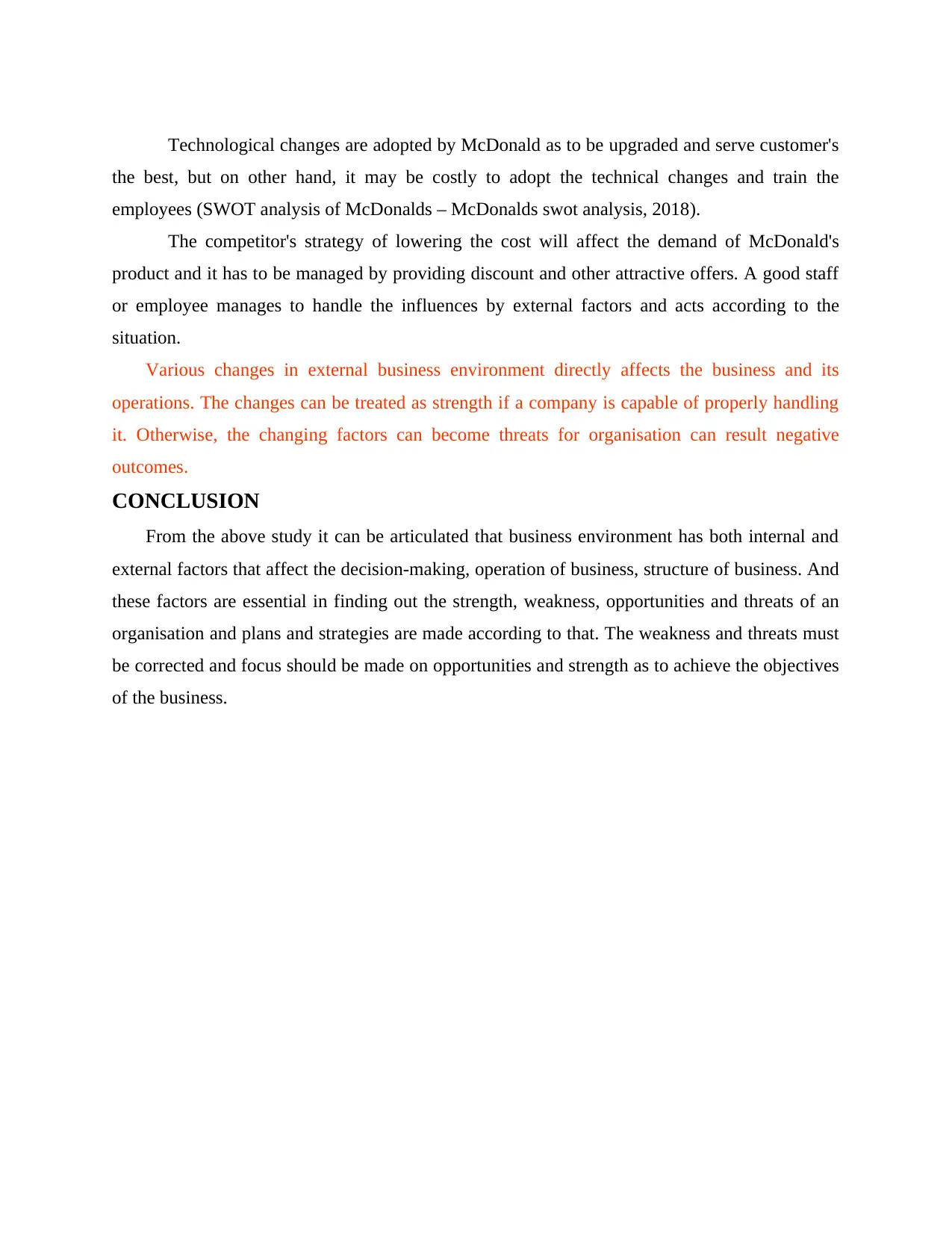
Technological changes are adopted by McDonald as to be upgraded and serve customer's
the best, but on other hand, it may be costly to adopt the technical changes and train the
employees (SWOT analysis of McDonalds – McDonalds swot analysis, 2018).
The competitor's strategy of lowering the cost will affect the demand of McDonald's
product and it has to be managed by providing discount and other attractive offers. A good staff
or employee manages to handle the influences by external factors and acts according to the
situation.
Various changes in external business environment directly affects the business and its
operations. The changes can be treated as strength if a company is capable of properly handling
it. Otherwise, the changing factors can become threats for organisation can result negative
outcomes.
CONCLUSION
From the above study it can be articulated that business environment has both internal and
external factors that affect the decision-making, operation of business, structure of business. And
these factors are essential in finding out the strength, weakness, opportunities and threats of an
organisation and plans and strategies are made according to that. The weakness and threats must
be corrected and focus should be made on opportunities and strength as to achieve the objectives
of the business.
the best, but on other hand, it may be costly to adopt the technical changes and train the
employees (SWOT analysis of McDonalds – McDonalds swot analysis, 2018).
The competitor's strategy of lowering the cost will affect the demand of McDonald's
product and it has to be managed by providing discount and other attractive offers. A good staff
or employee manages to handle the influences by external factors and acts according to the
situation.
Various changes in external business environment directly affects the business and its
operations. The changes can be treated as strength if a company is capable of properly handling
it. Otherwise, the changing factors can become threats for organisation can result negative
outcomes.
CONCLUSION
From the above study it can be articulated that business environment has both internal and
external factors that affect the decision-making, operation of business, structure of business. And
these factors are essential in finding out the strength, weakness, opportunities and threats of an
organisation and plans and strategies are made according to that. The weakness and threats must
be corrected and focus should be made on opportunities and strength as to achieve the objectives
of the business.
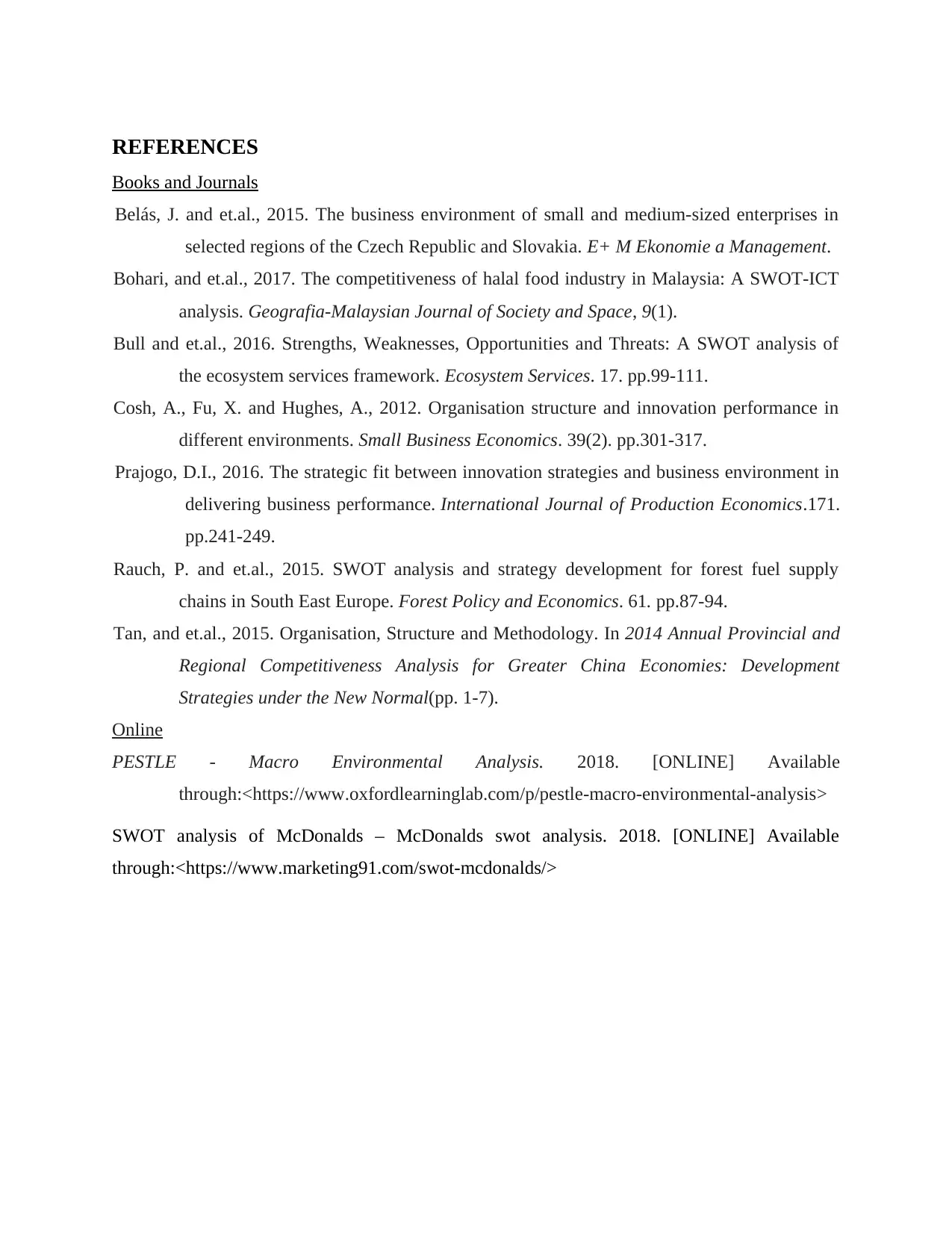
REFERENCES
Books and Journals
Belás, J. and et.al., 2015. The business environment of small and medium-sized enterprises in
selected regions of the Czech Republic and Slovakia. E+ M Ekonomie a Management.
Bohari, and et.al., 2017. The competitiveness of halal food industry in Malaysia: A SWOT-ICT
analysis. Geografia-Malaysian Journal of Society and Space, 9(1).
Bull and et.al., 2016. Strengths, Weaknesses, Opportunities and Threats: A SWOT analysis of
the ecosystem services framework. Ecosystem Services. 17. pp.99-111.
Cosh, A., Fu, X. and Hughes, A., 2012. Organisation structure and innovation performance in
different environments. Small Business Economics. 39(2). pp.301-317.
Prajogo, D.I., 2016. The strategic fit between innovation strategies and business environment in
delivering business performance. International Journal of Production Economics.171.
pp.241-249.
Rauch, P. and et.al., 2015. SWOT analysis and strategy development for forest fuel supply
chains in South East Europe. Forest Policy and Economics. 61. pp.87-94.
Tan, and et.al., 2015. Organisation, Structure and Methodology. In 2014 Annual Provincial and
Regional Competitiveness Analysis for Greater China Economies: Development
Strategies under the New Normal(pp. 1-7).
Online
PESTLE - Macro Environmental Analysis. 2018. [ONLINE] Available
through:<https://www.oxfordlearninglab.com/p/pestle-macro-environmental-analysis>
SWOT analysis of McDonalds – McDonalds swot analysis. 2018. [ONLINE] Available
through:<https://www.marketing91.com/swot-mcdonalds/>
Books and Journals
Belás, J. and et.al., 2015. The business environment of small and medium-sized enterprises in
selected regions of the Czech Republic and Slovakia. E+ M Ekonomie a Management.
Bohari, and et.al., 2017. The competitiveness of halal food industry in Malaysia: A SWOT-ICT
analysis. Geografia-Malaysian Journal of Society and Space, 9(1).
Bull and et.al., 2016. Strengths, Weaknesses, Opportunities and Threats: A SWOT analysis of
the ecosystem services framework. Ecosystem Services. 17. pp.99-111.
Cosh, A., Fu, X. and Hughes, A., 2012. Organisation structure and innovation performance in
different environments. Small Business Economics. 39(2). pp.301-317.
Prajogo, D.I., 2016. The strategic fit between innovation strategies and business environment in
delivering business performance. International Journal of Production Economics.171.
pp.241-249.
Rauch, P. and et.al., 2015. SWOT analysis and strategy development for forest fuel supply
chains in South East Europe. Forest Policy and Economics. 61. pp.87-94.
Tan, and et.al., 2015. Organisation, Structure and Methodology. In 2014 Annual Provincial and
Regional Competitiveness Analysis for Greater China Economies: Development
Strategies under the New Normal(pp. 1-7).
Online
PESTLE - Macro Environmental Analysis. 2018. [ONLINE] Available
through:<https://www.oxfordlearninglab.com/p/pestle-macro-environmental-analysis>
SWOT analysis of McDonalds – McDonalds swot analysis. 2018. [ONLINE] Available
through:<https://www.marketing91.com/swot-mcdonalds/>
1 out of 16
Related Documents
Your All-in-One AI-Powered Toolkit for Academic Success.
+13062052269
info@desklib.com
Available 24*7 on WhatsApp / Email
![[object Object]](/_next/static/media/star-bottom.7253800d.svg)
Unlock your academic potential
© 2024 | Zucol Services PVT LTD | All rights reserved.





